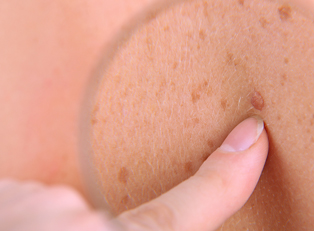Melanoma is a serious form of cancer that affects the cells containing skin pigment. In a majority of cases, it develops because of an overexposure to UV light, which is produced most commonly by the sun and tanning beds. While the disease can be fatal if left untreated, it’s actually quite easy to remove if it’s detected early enough.
Stages of Melanoma
Treatment for melanoma varies by severity of the condition, which is measured in stages that span from 0 (which is the easiest to treat) to IV (which is the hardest to treat). Depending on the stage, doctors may use surgery, chemotherapy, radiation, immunotherapy, targeted therapy, or a combination of two or more of these.
Stage 0 Treatment
At stage 0, a person’s melanoma has not progressed further than the epidermis layer of the skin and is very easy to remove, often through surgery. Doctors will typically remove the melanoma as well as one-fifth of an inch of the skin that surrounds it. This skin is then tested for cancer cells itself, and if the test is positive, more skin will be removed.
Some doctors may prefer to treat stage 0 melanoma with radiation therapy, but this is viewed as a controversial decision by some, since the cancer can still be removed with surgery at this point.
Stage I Treatment
Stage I melanoma is thicker than stage 0 but is still relatively small and easy to treat. At this point, it’s highly unlikely that the cancer has spread to other areas of the body. Because of this, surgery is still the most popular method of treatment. However, more surrounding skin must be removed when dealing with stage I melanoma—about four-fifths of an inch is necessary.
If stage I melanoma occurs near the lymph nodes, a doctor may order a lymph node biopsy to see if the cancer has spread to them. If this test comes back positive, it will probably be necessary to surgically remove the lymph nodes that are close by the melanoma. This reduces the risk of further spreading.
Stage II Treatment
Melanoma is classified as stage II if it is between one and four millimeters thick, depending on whether or not is has broken through the skin in a process known as ulceration. As with stage 0 and I, the primary mode of treatment is still surgical removal, although even more healthy skin must be removed with the melanoma than in stage I.
At this point in the disease, the likelihood that the cancer has spread to the lymph nodes is much greater, which means that a lymph node biopsy is almost always recommended, and the affected ones must be surgically removed as well. Additionally, a type of immunotherapy called interferon may be used. This medicine stimulates a person’s immune system and hopefully encourages it to attack the cancer cells.
Stage III Treatment
By stage III, the melanoma has spread to nearby lymph nodes, and there’s even the possibility that it has spread further than that. Additionally, new tumors may begin to appear near the site of the original melanoma. By this point, the disease is difficult to treat and will probably require a combination of surgery and radiation therapy, especially if the cancer has spread to multiple lymph nodes. If multiple melanomas are present, chemotherapy may also be a good choice in stage III.
Stage IV Treatment
In stage IV, the cancer has moved through the lymph nodes and into other parts of the body, such as the liver, lungs, or brain. By this point, treatment is very difficult and revolves around delaying death instead of curing the disease completely. Both radiation and chemotherapy are common options in stage IV, but many patients also participate in clinical trials for experimental treatments.



